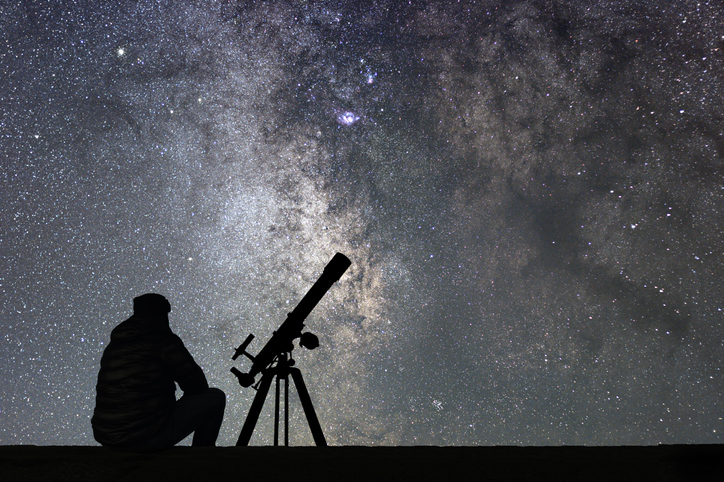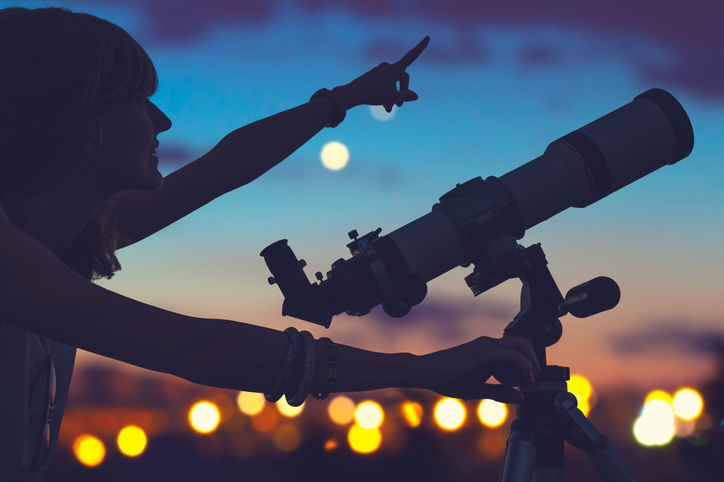This increasingly popular trend combines sustainability, tourism and scientific research. What’s more, Spain is one of the world’s best locations for gazing at the stars
Few experiences compare to that of gazing at the stars of a dark night’s sky. The show offered by the setting sun, giving way to thousands of endless twinkles, has always managed to pierce the retina and spellbind the spectator. This is the very same sensation felt by several key figures throughout human history: from the early research of Galileo Galilei to the painting “Saturn devouring his son” by baroque artist, Rubens. The stellar beauty that was reflected from century-to-century, through written pieces and paintings of the time, remains, just waiting to be enjoyed by new onlookers. This is astrotourism.
More and more people are taking up an interest in astronomy, with enthusiasts demanding spaces far from the light pollution of cities that allow them to put their telescopes to better use. It’s well known that stargazing is impossible in large cities, so increasing numbers of people are requesting more natural surroundings from where it is possible to enjoy their hobby. Spain certainly has a sky to be gazed at – an atmospheric element which, at the end of the day, appears to envelop the whole world. The country currently sits top of the Starlight Foundation’s international list of astrotourism destinations and reserves, certifying the quality of its starry night skies.

Founded in 2007, under the auspice of the Canary Islands Institute of Astrophysics and counting on UNESCO support, the Starlight Foundation is a non-profit institution which aims to disseminate astronomy to promote tourism development and protect nocturnal habitats.
Spain has over ten destinations with this certification. According to the institution, in the last year alone, astrotourism has increased in popularity by around 300%. The art and science of being carried away by the light, silence and mystery of these celestial bodies has already enamoured many tourists, with many more awaiting the chance to experience it for the first time.
Are you thinking of organising your first adventure in search of constellations, nebula and planets?
Below you will find a list of the best spots in Spain for enjoying the beauty of a starry night sky from an observatory.
- Castelltallat Astronomical Observatory – Barcelona: The Sierra de Castelltallat belongs to the largest unpopulated Catalan municipality, San Mateo de Bages. At almost 1000 metres above sea level, alongside the ruins of the Montedono Castle, a modern astronomical observatory opens its doors. Among other features, this observatory has an impressive 5-metre diameter dome which hosts weekly family workshops, teaching participants the best stargazing techniques.
- El Torcal Astronomical Observatory – Malaga: The natural landscape of El Torcal is a reminder of the Earth’s extensive stellar journey: the passing of time and erosion have shaped an impressive karstic landscape, first formed in the Jurassic period. Its privileged location, sitting 1200 metres above sea level, makes it an excellent vantage point for looking at the stars. The Observatory was built by the Andalusian regional government in 2010, next to the El Torcal nature reserve.
- Mallorca Astronomical Observatory – Mallorca: Based in the town of Costitx, the Mallorca Astronomical Observatory celebrated its silver jubilee in 2015, holding various open-door events for all sorts of audiences and ages. Its aim, on this occasion, was not to discover asteroids or to catch a perfect view of the skies. Instead, it was to open the door to astronomical research for tourists visiting the largest of the Balearic Islands. Its current challenge is to seek and photometer many stars, while also raising awareness of this attractive science that ensures its survival.
- Tefía Astronomical Observatory – Fuerteventura: In 2009, the island of Fuerteventura was declared a UNESCO Biosphere Reserve, underlining its strong commitment for sustainable economic development. The preservation of its night skies, free of light pollution, is one of its most important hallmarks. The Tefía Astronomical Observatory looks up to one of Spain’s most spectacular night skies.
- Roque de los Muchachos Observatory – La Palma: The environmental characteristics of the island of La Palma make it truly unique. The Roque de los Muchachos Observatory stands at 2426 metres above sea level, where there is a clean and turbulence-free atmosphere that is stabilised by trade winds. The location of this Canarian observatory means it can be combined with stays in rural tourism houses, which have the basic instruments needed to gain a better understanding of the natural lights that shine above them.
- Roque Saucillo Centre of Astronomy – Gran Canaria: The island of Gran Canaria has many of the characteristics required for observing the universe: high peaks, clear skies and not much wind. The best stargazing spots are located at the highest points of its valleys, thanks to a phenomenon known as “Donkey’s Belly”, in which a coming together of the clouds at an altitude of no more than 500 metres blocks out the light of the city. In addition to the good atmospheric conditions, astronomy has been gaining popularity on the island thanks to the Roque Saucillo Centre of Astronomy, which holds activities all year-round.
- Borobia Astronomical Observatory- Soria: There is a good story behind the history of astronomy being taught in Spain. In 1995, a group of neighbours from a village in the Sorian slopes of Moncayo joined forces to promote the construction of what, in 2002, would be Spain’s first astrotourism observatory. Nowadays, Borobia and its dome, sitting 1200 metres above sea level, continue to set the benchmark in the country. Each summer, guided tours and meet-ups are held, giving visitors the chance to learn about Spain’s first window into the universe.
Star Parks
Another certification created by the Fundación Starlight, accrediting spaces with excellent sky quality that are fantastic examples of protection and conservation, are the so-called Star Parks. These parks are in areas that are usually linked to municipalities that protect their sky, allowing for observation, teaching, cultural and entertainment activities to be held that are related to astrological events. These activities are usually led by amateur astrologists. These are “viewpoints open to the sky”, promoted by administrations, organisations and private entities to encourage the hobby of stargazing and learning about astrology. Spain currently has five star parks:
- El Jabalón
- Tiedra Astronomical Centre (Cielo y Tiedra)
- Santa Catalina Botanical Garden
- Tenerife Sky at Night
- Gorafe Sky Interpretation Centre







